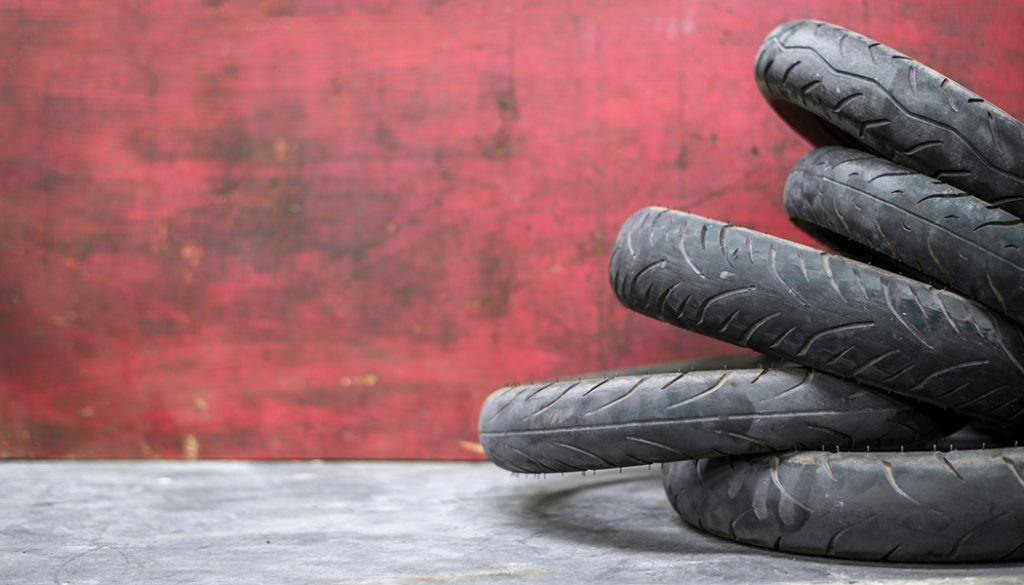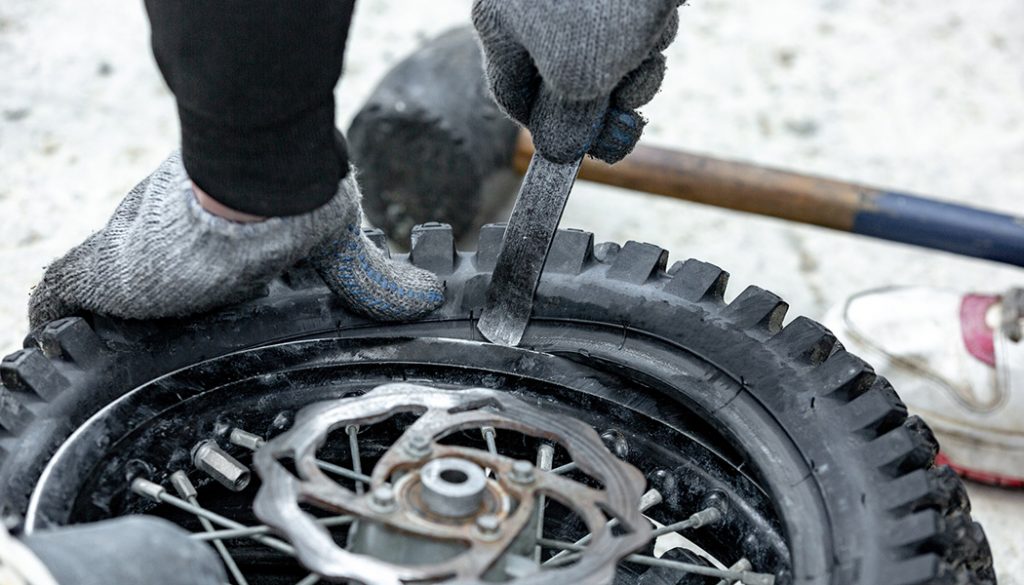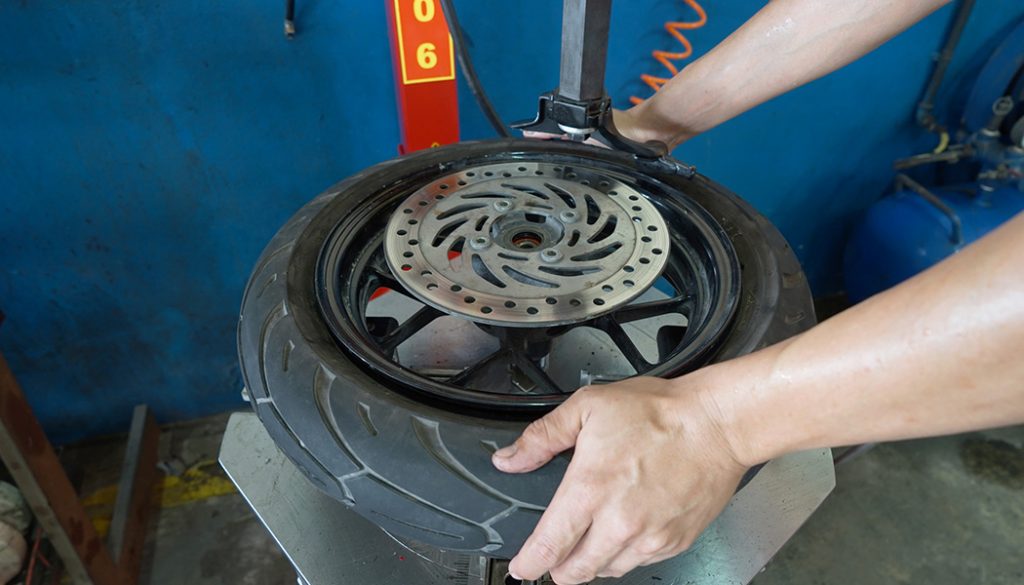
If you've had a bike long, you've probably noticed that those tiny tires wear at a huge rate. So we help you learn how to change a motorcycle tire.
Two-Wheel Flat? Here’s How to Change a Motorcycle Tire
When you get into the hobby of motorcycle ownership, you soon discover that motorcycle tires wear out very quickly. It can be astonishing to see that the tires on your motorcycle don’t last nearly as long as the tires on your car, meaning that you’ll quickly be asking how to change a motorcycle tire.
Average quality car tires can last 40,000 miles, and premium car tires typically last much longer than that. But the average motorcycle tire will only be good for about 10,000 miles. If you are lucky, have moderate riding habits, don’t carry a lot of weight on the bike, and are a stickler for good tire maintenance, then you can perhaps squeeze another few thousand miles out of them. But not much. Even worse, performance tires that are made with soft, sticky, road grabbing, rubber compounds will wear out more rapidly. They won’t even see the 10,000-mile mark.
Either way, not long into the hobby you will be faced with the chore of motorcycle tire replacement. Let’s break it down into two parts; getting the wheels off the bike, and deciding whether to wrestle the tires off the rims or pay a repair shop to do it with their modern equipment. Let’s see which avenue of attack is best when you’re looking at how to change a motorcycle tire.

Why Don’t Motorcycle Tires Last as Long as Your Car’s Tires?
- Your car does not lean into turns, but the bike surely does lean, sometimes to amazing degrees.
- The typical car driver does not accelerate or brake as aggressively as the average bike rider does. The next time you are out for a ride, take notice of how you accelerate and brake compared to how you drive your car. The lighter machine will naturally move away from stops and brake to halts quicker than a heavy vehicle does.
- Car tire treads are made from hard rubber compounds for long life, whereas bike tires are made from much softer compounds to give better traction.
- People seem not to mind driving on car tires until they get the last possible life out of them. The same people, however,will change their motorcycle’s tires long before they are totally worn out. It makes sense.
All those factors lead to the regular chore of motorcycle tire replacement. That’s why it’s good to know how to change a motorcycle tire.
How to Get the Wheels Off Your Bike?
If your bike has a center stand, that will make it convenient when it’s time to remove the wheels. If it doesn’t, though, you will need to purchase a motorcycle jack.
Types of Motorcycle Jacks
Motorcycle jacks range from inexpensive, simple devices to elaborate pneumatic-powered platforms that rival NASCAR pit crew equipment. Which is best?
The inexpensive scissor-type motorcycle jack will work well. Use it only on hard, level surfaces like concrete. If you live in an apartment, then take the bike to a buddy’s house to work on it in their garage.
Resist the urge to use car jacks, bricks, or blocks of wood to prop your bike up. Even when lifted on the best motorcycle jacks, bikes are precariously perched. They have a high center of gravity, and that makes them easy to knock over. Don’t risk it with bricks or blocks of wood.
Use A Tie-Down Strap for Safety
Speaking of risk, here’s a common scenario when learning how to change a motorcycle tire. A bike is raised on its center stand, and then its front wheel is removed. Somehow in the process of being worked on, the bike will get nudged forward. That makes the center stand retract to its resting position, which brings the bike crashing down onto its front fork tubes. It only takes a second to happen. It can also happen when only the rear wheel is removed. Either way, damage can be expensive.
A word to the wise then. Before removing a wheel, either front or rear, secure the center stand in its down position with the tie-down strap. Lock the stand good and solid to the frame so it can’t retract, especially when you are wrestling the wheels back onto the bike.
What Typically Holds the Wheels on the Bike?
For typical front wheels, the most common arrangement is a long axle that is secured to the fork tubes with an aluminum cap on each fork leg. It’s simple yet effective. Just be sure to disconnect the speedometer cable from the front wheel before you let the wheel drop down. While you have the front wheel off, it’s a good opportunity to apply some grease to that often-neglected speedometer cable when you work on how to change a motorcycle tire.
Rear wheels also have a long axle. A little more complex, though, their axle goes through two moveable chain or belt adjusters, one on each side of the bike. Also, to contend with, are spacers that center the rear wheel in the swing arm. Typically, you will find a short spacer on one side of the wheel and a long one on the opposite side. Keep track of which is which. You will have to wrestle those spacers back into position when you manhandle the wheel back onto the bike and thread the axle back into position, all the while trying to get the chain onto its sprocket, and the rear disc caliper aligned over the disc rotor. Sheesh, that’s how bikes get knocked off their center stands. Be careful. Get a friend to help.
What If Your Bike Has a One-Sided Swingarm?
Congratulations. You have a fancy set up. It does require a special wrench to get that jumbo-sized nut loose. Buy it from your dealer or online.

Dismount the Tire Yourself or Let A Shop Do It?
Now that you have one or both wheels off your bike when you’re learning how to change a motorcycle tire (doing just one wheel at a time is safer because there is less chance of knocking the bike over), your well-meaning friends will tell you to wrestle the old tire off the rim and to manhandle the new tire on in its place.
Most of us would never think of dismounting our car tires like that. It only costs a few dollars to let a tire store do it, which is a bargain for the amount of work and expensive equipment the task requires.
But if you feel the need to work long and hard to save only a few dollars, cheer up. There are tons of YouTube videos that show you how to change a motorcycle tire and undergo the ordeal. Rather than repeat the info that is already out there, let’s instead talk about the things those well-meaning videos don’t tell you. What’s missing? Specifically, let’s look at how easy it is to damage the wheel or to injure yourself.
Four Things to Expect If You Try to Save A Few Dollars
- You can easily bend a brake rotor. The YouTube videos will depict a friendly mechanic working very awkwardly on the ground with big tire irons, dismounting the old tire and slowly prying the new tire onto the rim. Yes, it is difficult work (that’s why we don’t change our own car tires), and perhaps it is a skill that might come in handy if you ever had to change a tire yourself far away from home. Let’s say the mechanic put the wheel on a piece of old carpet to prevent scratching it, but the wheel is still flopping around like a fish on dry ground as they vainly try to pry the tire loose. That can easily bend a brake rotor, which is a very expensive part to replace. For that reason, some people will place the wheel on top of a paint bucket or a garbage can, in an attempt to shield the delicate brake rotor from harm. Here’s another way to approach the problem. Do a cost-benefit analysis. How much are you saving on labor versus the risk of buying a new brake rotor or two? Still can’t decide? Look up the price of a new brake rotor before you buy those tire irons.
- You can mar the wheel where the tire seals to it when you’re learning how to change a motorcycle tire, which will cause slow leaks that can’t be stopped. Yes, the videos show how you can purchase (more money spent) plastic guards that will prevent the tire irons from marring the outside of the wheel – if everything goes right. But levering the new tire on to the rim can cause scratches inside the wheel rim, where the tubeless tire seals against it. Without a smooth surface, you could be plagued with slowly leaking tires. It is really aggravating.
- You won’t be able to accurately balance the wheel and tire assembly. Yep, ‘everybody’ seems to tell you to balance the assembly by gravity. Let it spin freely, and the heavy spot will sink to the bottom. But tire dynamics change when there is the weight of the motorcycle and rider on them, and the wheel is spinning at high speed. That’s why electronic tire balancers balance the tire and wheel as two separate planes, the inner half and the outer half. To see that in effect, look at your car’s tires. You’ll see balance weights at different locations inside the wheel and on the outer rim.
- You could get hurt. Let’s face it, of all the pleasant chores we do to maintain our motorcycles and cars, wrestling tires off of rims and back on to them is not one of them. One bash from a tire iron that flung loose and got away will convince us to bring the wheels to a shop and pay them to change the tires for us.

Benefits of Letting A Shop Do It
Besides avoiding injury, damage to the brake rotors or wheel rims, and gaining a smoother ride from having a properly balanced tire and wheel, look at the important stuff too. While the shop switches your new tires onto the wheels, you can browse through all the neat accessories they have for sale. Besides, you are also building a relationship with a local mechanic, and you might need his or her advice someday. Yes, and give them a tip for being careful with your wheels.
Wheel Alignment on Motorcycles
One last word as you reinstall the rear wheel adjusters. The rear wheel has to point straight ahead. Otherwise, the bike will track to the left or right. Get into the habit of sighting down the two tires to see if the rear tire is aligned with the front wheel or you might be honing your skills even more quickly on how to change a motorcycle tire.





